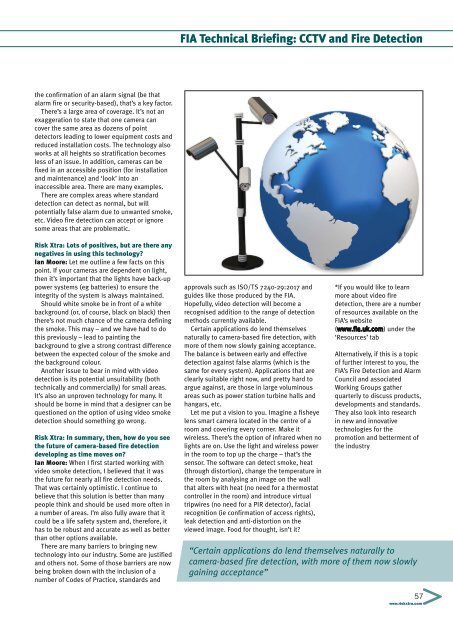RiskXtraDecember2018
Create successful ePaper yourself
Turn your PDF publications into a flip-book with our unique Google optimized e-Paper software.
FIA Technical Briefing: CCTV and Fire Detection<br />
the confirmation of an alarm signal (be that<br />
alarm fire or security-based), that’s a key factor.<br />
There’s a large area of coverage. It’s not an<br />
exaggeration to state that one camera can<br />
cover the same area as dozens of point<br />
detectors leading to lower equipment costs and<br />
reduced installation costs. The technology also<br />
works at all heights so stratification becomes<br />
less of an issue. In addition, cameras can be<br />
fixed in an accessible position (for installation<br />
and maintenance) and ‘look’ into an<br />
inaccessible area. There are many examples.<br />
There are complex areas where standard<br />
detection can detect as normal, but will<br />
potentially false alarm due to unwanted smoke,<br />
etc. Video fire detection can accept or ignore<br />
some areas that are problematic.<br />
Risk Xtra: Lots of positives, but are there any<br />
negatives in using this technology?<br />
Ian Moore: Let me outline a few facts on this<br />
point. If your cameras are dependent on light,<br />
then it’s important that the lights have back-up<br />
power systems (eg batteries) to ensure the<br />
integrity of the system is always maintained.<br />
Should white smoke be in front of a white<br />
background (or, of course, black on black) then<br />
there’s not much chance of the camera defining<br />
the smoke. This may – and we have had to do<br />
this previously – lead to painting the<br />
background to give a strong contrast difference<br />
between the expected colour of the smoke and<br />
the background colour.<br />
Another issue to bear in mind with video<br />
detection is its potential unsuitability (both<br />
technically and commercially) for small areas.<br />
It’s also an unproven technology for many. It<br />
should be borne in mind that a designer can be<br />
questioned on the option of using video smoke<br />
detection should something go wrong.<br />
Risk Xtra: In summary, then, how do you see<br />
the future of camera-based fire detection<br />
developing as time moves on?<br />
Ian Moore: When I first started working with<br />
video smoke detection, I believed that it was<br />
the future for nearly all fire detection needs.<br />
That was certainly optimistic. I continue to<br />
believe that this solution is better than many<br />
people think and should be used more often in<br />
a number of areas. I’m also fully aware that it<br />
could be a life safety system and, therefore, it<br />
has to be robust and accurate as well as better<br />
than other options available.<br />
There are many barriers to bringing new<br />
technology into our industry. Some are justified<br />
and others not. Some of those barriers are now<br />
being broken down with the inclusion of a<br />
number of Codes of Practice, standards and<br />
approvals such as ISO/TS 7240-29:2017 and<br />
guides like those produced by the FIA.<br />
Hopefully, video detection will become a<br />
recognised addition to the range of detection<br />
methods currently available.<br />
Certain applications do lend themselves<br />
naturally to camera-based fire detection, with<br />
more of them now slowly gaining acceptance.<br />
The balance is between early and effective<br />
detection against false alarms (which is the<br />
same for every system). Applications that are<br />
clearly suitable right now, and pretty hard to<br />
argue against, are those in large voluminous<br />
areas such as power station turbine halls and<br />
hangars, etc.<br />
Let me put a vision to you. Imagine a fisheye<br />
lens smart camera located in the centre of a<br />
room and covering every corner. Make it<br />
wireless. There’s the option of infrared when no<br />
lights are on. Use the light and wireless power<br />
in the room to top up the charge – that’s the<br />
sensor. The software can detect smoke, heat<br />
(through distortion), change the temperature in<br />
the room by analysing an image on the wall<br />
that alters with heat (no need for a thermostat<br />
controller in the room) and introduce virtual<br />
tripwires (no need for a PIR detector), facial<br />
recognition (ie confirmation of access rights),<br />
leak detection and anti-distortion on the<br />
viewed image. Food for thought, isn’t it?<br />
*If you would like to learn<br />
more about video fire<br />
detection, there are a number<br />
of resources available on the<br />
FIA’s website<br />
(www.fia.uk.com) under the<br />
‘Resources’ tab<br />
Alternatively, if this is a topic<br />
of further interest to you, the<br />
FIA’s Fire Detection and Alarm<br />
Council and associated<br />
Working Groups gather<br />
quarterly to discuss products,<br />
developments and standards.<br />
They also look into research<br />
in new and innovative<br />
technologies for the<br />
promotion and betterment of<br />
the industry<br />
“Certain applications do lend themselves naturally to<br />
camera-based fire detection, with more of them now slowly<br />
gaining acceptance”<br />
57<br />
www.riskxtra.com>

















